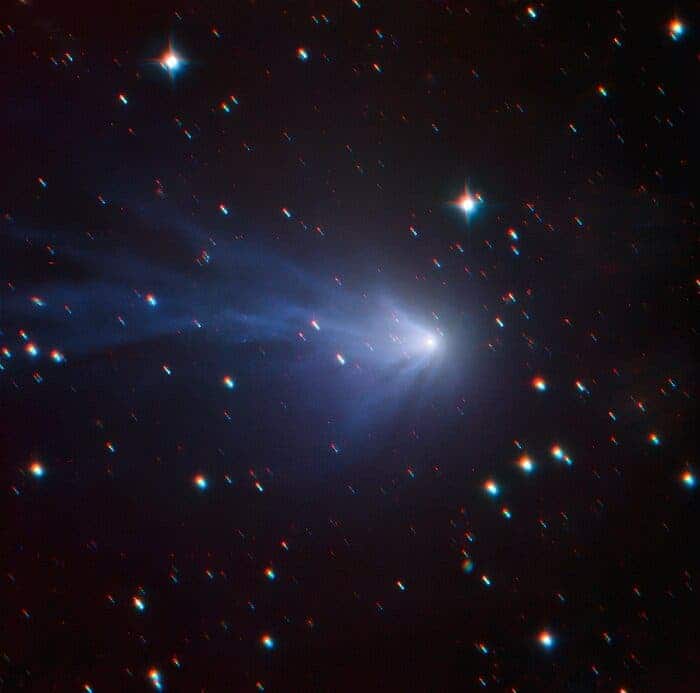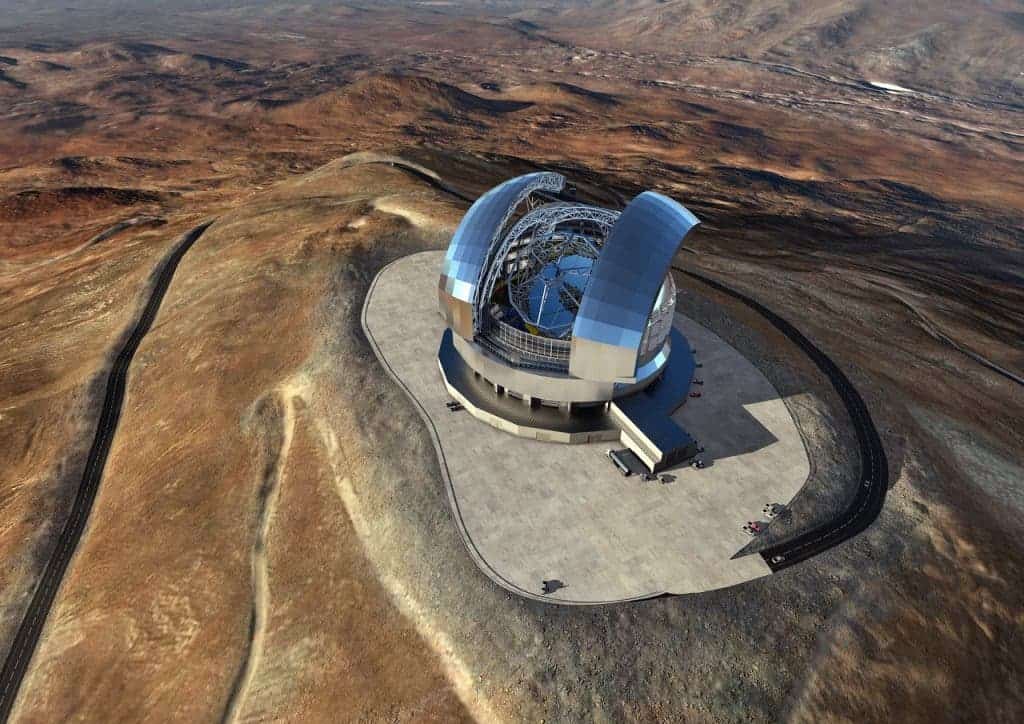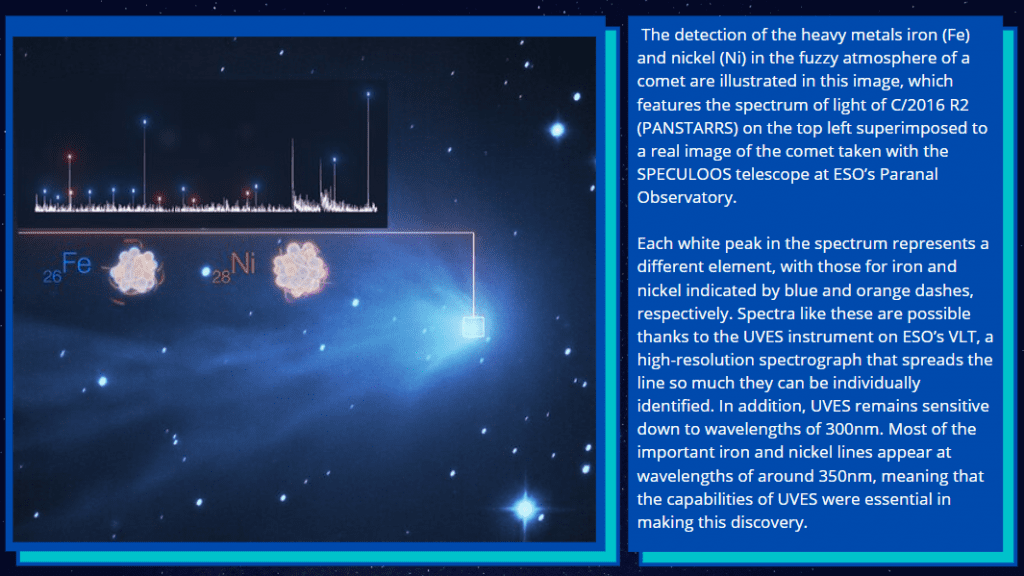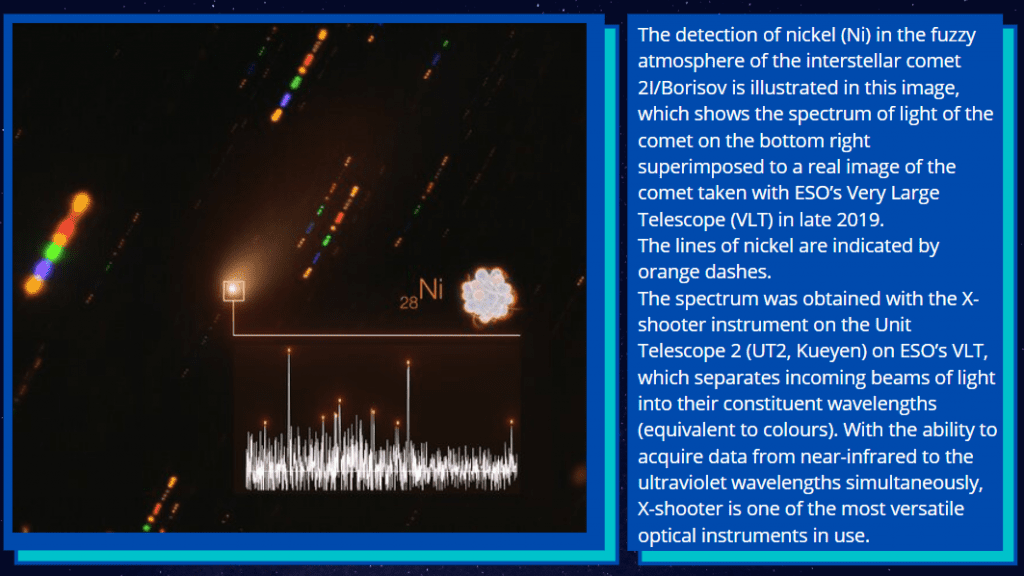Using data collected by the Very Large Telescope (VLT) a team of astronomers has discovered iron and nickel in the atmosphere of around 20 different solar system comets–including some located far away from the Sun.
These findings will come as a surprise to astronomers because even though such heavy metals have been known to exist in solid form within comet interiors before, the vapour of such elements has only previously been associated with cometary atmospheres in hot environments.
This is the first time such vapour has been seen in the cooler atmospheres of comets that exist far from a star and could indicate some previously unknown mechanism or material on the surface of comets.
“It was a big surprise to detect iron and nickel atoms in the atmosphere of all the comets we have observed in the last two decades, about 20 of them, and even in ones far from the Sun in the cold space environment,” says Jean Manfroid, of the University of Liège, Belgium.
This wasn’t the only surprise the team found, however. The Belgian astronomers–who have been studying comets with the VLT for 20 years–observed nickel and iron in the atmosphere of the comet in equal amounts.
Generally, iron is about ten times more abundant in the solar system than nickel, and comets are believed to be material left over from the formation of planetary bodies within the solar system. That means it’s something of a mystery why the comets the team observed should have such a relatively large abundance of nickel.
“Comets formed around 4.6 billion years ago, in the very young Solar System, and haven’t changed since that time. In that sense, they’re like fossils for astronomers,” Emmanuel Jehin, also from the University of Liège. “This discovery went under the radar for many years.”
Manfroid and Jehin are two of the authors of a paper published in the latest edition of the journal Nature documenting the team’s findings. And that isn’t the only research revealing metal in the atmosphere of such a body published in Nature this month.
The discovery is accompanied by the revelation that a separate team of researchers, this time located in Poland, has also found traces of nickel vapour in the atmosphere around the interstellar visitor 2l/Borisov.
This comet may sound familiar as it made headlines in 2019 when it became only the second object found within the solar system which originated from outside our planetary system.
A paper detailing this second finding is also published in this month’s Nature.
Heavy Metal Rocks
Astronomers have known for some time that a variety of metals exist within the icy and rocky interiors of comets. There have even been suggestions that spent comets could be mined for precious or useful metals like gold, silver, platinum and iron.

These solid metals within comets were not expected to be found as gases in the body’s atmosphere, though, unless that body is passing within close vicinity to a star.
It is the heat from these close brushes with stars like the Sun that causes solid metals within comets to ‘sublimate’–the process by which solid material changes directly into a gaseous state.
That means that distant comets in the cold environment of space away from the heat of the Sun shouldn’t have heavy metal atmospheres.
Yet, despite this, researchers have now found nickel and iron vapour in the atmospheres of comets up to 480 million kilometres from the Sun. A distance that is three astronomical units, or three times the distance between the Sun and the Earth.
In order to make this discovery, the team employed the technique of spectroscopy which reveals the signatures of specific chemical elements and the Ultraviolet and Visual Echelle Spectrograph (UVES) instrument on the VLT to assess the chemical composition of comets’ atmospheres.
The spectral lines of nickel and iron found by the team in comets’ atmospheres were extremely faint, which leads them to believe that the reason such elements have been missed in past is due to their tiny abundance. The team says that for every 100kg of water in the atmosphere of the comets they studied there is just one gram of iron and nickel respectively.
The Belgian astronomers believe that the equal amounts of iron and nickel together with the sublimation at low temperatures means there is something undiscovered at the surface of the comets they studied.

“Usually there is 10 times more iron than nickel, and in those comet atmospheres we found about the same quantity for both elements,” explains Damien Hutsemékers, also a member of the Belgian team from the University of Liège.”We came to the conclusion they might come from a special kind of material on the surface of the comet nucleus, sublimating at a rather low temperature and releasing iron and nickel in about the same proportions.”
The team intends to attempt to use new telescope technology such as the Mid-infrared ELT Imager and Spectrograph (METIS) on ESO’s upcoming Extremely Large Telescope (ELT)–currently under construction in the Atacama Desert region of Northern Chile– to discover what this material is.
The findings of this team are accompanied by the revelation that nickel vapour has also been discovered in the atmosphere of 2I/Borisov.
2I/Borisov: The Interstellar Intruder that keeps giving
The discovery that metal is also present in the atmosphere of the interstellar visitor 2I/Borisov was made by a team of astronomers in Poland. The team also used the VLT to catch a glimpse of the interstellar comet as it passed through the solar system.
The data collected with the VLT’s X-Shooter spectrograph revaled nickel vapour in the cold envlope surround 2I/Borisov.
ESO/L. Calçada/O. Hainaut, P. Guzik and M. Drahus
The discovery marks another surprise for astronomers, as again it details the discovery of sublimated heavy metals in a cold atmosphere.
“At first we had a hard time believing that atomic nickel could really be present in 2I/Borisov that far from the Sun,” says Piotr Guzik, the Jagiellonian University, Poland, a co-author on this second study. “It took numerous tests and checks before we could finally convince ourselves.”
This latter study shows that nickel was not uniquely present during the formation of our solar system, but as it can be seen in a comet from another planetary grouping, it may well be common in many such conglomerations.
“All of a sudden we understood that gaseous nickel is present in cometary atmospheres in other corners of the Galaxy,” Michał Drahus, also from the Jagiellonian University and another of the paper’s co-authors, says.
In unison, both these studies indicate that the comets of this solar system and the interstellar visitor 2I/Borisov share many similarities. Dahus adds: “Now imagine that our Solar System’s comets have their true analogues in other planetary systems — how cool is that?”
Jehin, meanwhile, believes these studies could inspire future research into cometary bodies and their atmospheres, and a re-examination of data already collected.
“Now people will search for those lines in their archival data from other telescopes,” the University of Liège researcher concludes. “We think this will also trigger new work on the subject.”




